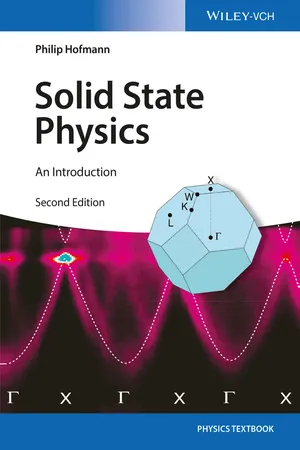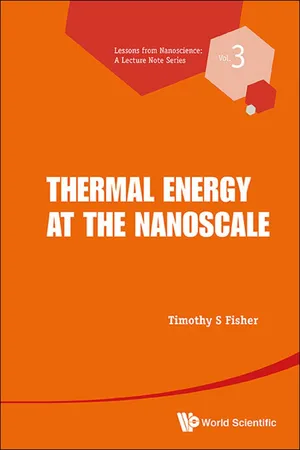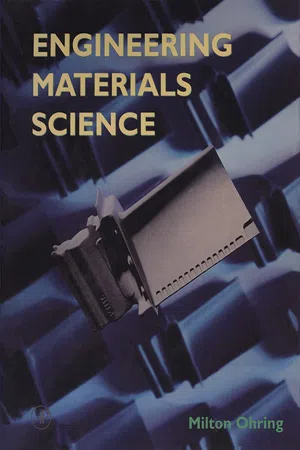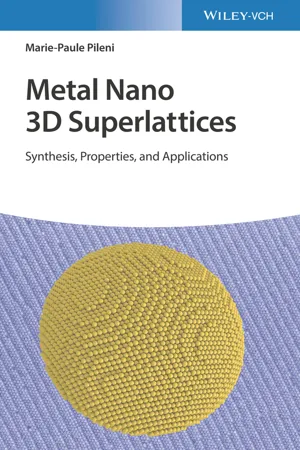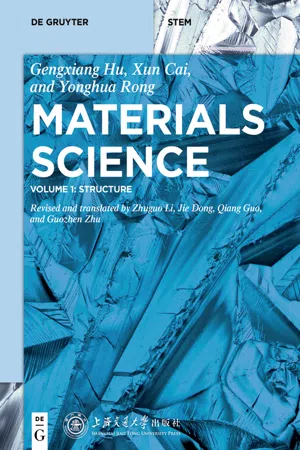Chemistry
Lattice Structures
Lattice structures refer to the arrangement of atoms, ions, or molecules in a crystalline solid. These structures are characterized by repeating units that form a three-dimensional framework. The arrangement of these units determines the physical and chemical properties of the material. Examples of lattice structures include the cubic, hexagonal, and tetragonal lattices.
Written by Perlego with AI-assistance
Related key terms
Related key terms
1 of 4
Related key terms
1 of 3
10 Key excerpts on "Lattice Structures"
- eBook - ePub
Physical Metallurgy
Principles and Design
- Gregory N. Haidemenopoulos(Author)
- 2018(Publication Date)
- CRC Press(Publisher)
metallic glasses . Metallic glasses can be produced by rapid solidification of metal droplets or by vacuum deposition on a substrate at low temperatures and exhibit interesting properties. Glasses are isotropic materials, i.e., they exhibit the same physical and chemical properties in all directions. On the other hand, crystalline materials are anisotropic and properties, such as thermal or electrical conductivity, thermal expansion and elastic constants depend on the direction of measurement. The anisotropy of crystals is exhibited during unconstrained crystal growth, where the external free surface of the growing crystal develops facets, associated with the crystal structure in the bulk of the material.2.3 The Crystal Lattice
As discussed above, a crystal is a periodic array of atoms in three-dimensional space. This structure can be described with respect to a three-dimensional net of straight lines, called the lattice . An example is depicted in Figure 2.1 . The lattice divides space into cells, defined by the unit vectorsanda →,b →c →. The cells are in contact on all faces and fill space entirely. The cell is then called the unit cell , since it plays the role of the building block for the whole crystal. Its repetition in three directions generates the crystal structure. The unit vectors define the periodicity of the crystal in the three directions. Every node of the lattice can be defined by the position vectorr →given byr →= ua →+ vb →+ wc →Figure 2.1: The crystal lattice. Periodicity is defined by unit vectors a, b and c.where u , v and w are integers corresponding to the coordinates of the point. The unit vectors form the reference axes of the crystal. Atoms in crystalline materials can be arranged in fourteen possible lattices, called the Bravais lattices . The unit cells of these lattices are depicted in Figure 2.2 . Each Bravais lattice is associated with a set of reference system of axes, which are not necessarily orthogonal while the unit vectors may not have the same magnitude. In crystallography, seven systems of axes are used for the description of lattices. The seven crystal systems are shown in Table 2.1 together with the relation between length and angles between axes.For the study of the structure of metals, it is important to describe crystallographic directions and crystal planes. A system of indices is employed. Since the vast majority of metals have either a cubic or a hexagonal structure, only the indices for these systems will be discussed. The direction of a line connecting the origin with a point, whose coordinates are u , v and w , is described by the notation [uvw ]. In this notation we do not use fractions but the smallest integers corresponding to the coordinates of the point. In Figure 2.3 - eBook - ePub
Solid State Physics
An Introduction
- Philip Hofmann(Author)
- 2015(Publication Date)
- Wiley-VCH(Publisher)
This chapter is divided into three parts. In the first part, we define some basic mathematical concepts needed to describe crystals. We keep things simple and mostly use two-dimensional examples to illustrate the ideas. In the second part, we discuss common crystal structures. At this point, we do not ask why the atoms bind together in the way that they do, as this is treated in the next chapter. Finally, we go into a somewhat more detailed discussion of X-ray diffraction, the experimental technique that can be used to determine the microscopic structure of crystals. X-ray diffraction is used not only in solid state physics but also for a wide range of problems in nanotechnology and structural biology.1.1 General Description of Crystal Structures
Our description of crystals starts with the mathematical definition of the lattice. A lattice is a set of regularly spaced points with positions defined as multiples of generating vectors. In two dimensions, a lattice can be defined as all the points that can be reached by the vectors , created from two vectors and as1.1where n and m are integers. In three dimensions, the definition is1.2Such a lattice of points is also called a Bravais lattice. The number of possible Bravais lattices that differ by symmetry is limited to 5 in two dimensions and to 14 in three dimensions. An example of a two-dimensional Bravais lattice is given in Figure 1.1 . The lengths of the vectors and are often called the lattice constants.Example for a two-dimensional Bravais lattice.Figure 1.1Having defined the Bravais lattice, we move on to the definition of the primitive unit cell. This is any volume of space that, when translated through all the vectors of the Bravais lattice, fills space without overlap and without leaving voids. The primitive unit cell of a lattice contains only one lattice point. It is also possible to define nonprimitive unit cells that contain several lattice points. These fill space without leaving voids when translated through a subset of the Bravais lattice vectors. Possible choices of a unit cell for a two-dimensional rectangular Bravais lattice are given in Figure 1.2 . From the figure, it is evident that a nonprimitive unit cell has to be translated by a multiple of one (or two) lattice vectors to fill space without voids and overlap. A special choice of the primitive unit cell is the Wigner–Seitz cell that is also shown in Figure 1.2 - eBook - ePub
- Timothy S Fisher(Author)
- 2013(Publication Date)
- WSPC(Publisher)
Chapter 3 applies equally well to fluid phases. Within the array of solid-state materials, single-crystal structures are the most amenable for initial study, although even these structures become rather complex in three dimensions with various atomic arrangements such as face-centered cubic (fcc), body-centered cubic (bcc), and diamond configurations that are perhaps most familiar to readers. To minimize digression, here we refer the reader to the many excellent textbooks on solid-state physics (Ashcroft and Mermin, 1976; Kittel, 2007) and crystallography (De Graef and McHenry, 2012) for advanced treatment of 3D crystals.We will focus on one- and two-dimensional lattices for the sake of expediency and because the 2D graphene lattice has high contemporary scientific and technological importance. A simple 1D structure is obtained by repeating the diatomic arrangement of Fig. 1.2 indefinitely. Figure 1.5 shows the resulting configuration, with each atom of mass m connected to its neighbor by a bond with spring constant g. The equilibrium separation between atoms is represented by the lattice constant a. Somewhat surprisingly, this simple, idealized structure will enable us to develop almost all the essential tools for analysis of lattice vibrations and their quantum manifestation—called phonons.Fig. 1.4 (a) Two isolated, self-contained atoms and associated electron energy states. (b) Quantized energy states upon bond formation between the two isolated atoms. Energy levels are modified as electron orbitals become shared in a bond.Because an ideal crystal extends infinitely in all directions, we must find a way to concentrate the analysis on a smaller region. Fortunately, the regular order, or periodicity, of a crystal lattice makes this task straightforward. A primitive unit cell of a lattice is one that, if repeated throughout all space by well-defined translational vectors, would fill the space entirely and with no overlapping regions or void spaces. Figure 1.6 shows an example for a 2D monatomic rectangular lattice. Several possible shapes, positions, and orientations of the primitive unit cell exist for this lattice, as indicated by the shaded regions. The arrows denote basis vectors that define the periodic translation of the unit cells throughout the domain. The set of all possible translations by integer indexing of basis vectors forms a so-called Bravais lattice, whose discrete points are given by the lattice vector - R. E. Smallman, R J Bishop(Authors)
- 1999(Publication Date)
- Butterworth-Heinemann(Publisher)
2.1b , one can appreciate why the structures of comparatively highly-ordered crystalline substances, such as chemical compounds, minerals and metals, have tended to be more amenable to scientific investigation than glasses.2.2 Crystal lattices and structures
We can rationalize the geometry of the simple representation of a crystal structure shown in Figure 2.1a by adding a two-dimensional frame of reference, or space lattice, with line intersections at atom centres. Extending this process to three dimensions, we can construct a similar imaginary space lattice in which triple intersections of three families of parallel equidistant lines mark the positions of atoms (Figure 2.2a ). In this simple case, three reference axes (x, y, z ) are oriented at 90° to each other and atoms are ‘shrunk’, for convenience. The orthogonal lattice of Figure 2.2a defines eight unit cells, each having a shared atom at every corner. It follows from our recognition of the inherent order of the lattice that we can express the geometrical characteristics of the whole crystal, containing millions of atoms, in terms of the size, shape and atomic arrangement of the unit cell, the ultimate repeat unit of structure.2Figure 2.2 Principles of lattice construction.We can assign the lengths of the three cell parameters (a, b, c ) to the reference axes, using an internationally-accepted notation (Figure 2.2b ). Thus, for the simple cubic case portrayed in Figure 2.2a , x = y = z = 90°; a = b = c . Economizing in symbols, we only need to quote a single cell parameter (a ) for the cubic unit cell. By systematically changing the angles (α , β , γ ) between the reference axes, and the cell parameters (a, b, c ), and by four skewing operations, we derive the seven crystal systems (Figure 2.3 ). Any crystal, whether natural or synthetic, belongs to one or other of these systems. From the premise that each point of a space lattice should have identical surroundings, Bravais demonstrated that the maximum possible number of space lattices (and therefore unit cells) is 14. It is accordingly necessary to augment the seven primitive (P) cells shown in Figure 2.3 with seven more non-primitive cells which have additional face-centring, body-centring or end-centring lattice points. Thus the highly-symmetrical cubic system has three possible lattices: primitive (P), body-centred (I; from the German word innenzentrierte ) and face-centred (F). We will encounter the latter two again in Section 2.5.1 . True primitive space lattices, in which each lattice point has identical surroundings, can sometimes embody awkward angles. In such cases it is common practice to use a simpler orthogonal non-primitive lattice which will accommodate the atoms of the actual crystal structure.1- eBook - ePub
Molecular Dynamics Simulation of Nanostructured Materials
An Understanding of Mechanical Behavior
- Snehanshu Pal, Bankim Chandra Ray(Authors)
- 2020(Publication Date)
- CRC Press(Publisher)
1Structural Description of Materials
1.1 ATOMIC ARRANGEMENTS IN MATERIALS
Materials are made up of atoms, molecules, and ions present in different states such as gas, liquid, and solid. According to the kinetic molecular theory, the atoms/molecules in solids vibrate and rotate at their respective places instead of moving. Solids have stronger attractive forces to hold molecules/atoms in contrast to liquids and gases. Solids acquire definite shapes and volumes and can also withstand some amount of shear forces without undergoing any deformation. Furthermore, solids can be broadly classified into two major categories, crystalline solids and amorphous solids, which are shown in Figure 1.1 . In crystalline solids, the atoms, ions, or molecules are arranged in a regular, well-defined periodic manner. In amorphous solids, the arrangement of atoms, ions, or molecules is disordered, with lacking periodicity.Crystalline solids can be divided into following four categories based on the types of particles (atom/ion/molecule) present and the types of bonding between the particles:1. Ionic solids 2. Metallic solids 3. Covalent network solids 4. Molecular solidsThe constituent particles, type of effective binding forces, and properties of different crystalline solids along with examples are presented in Table 1.1 .1.1.1 PERIODICITY IN CRYSTALS AND SYMMETRY ELEMENTSThe basic difference between crystals and non-crystals is that atomic arrangement in crystals is in the form of a periodic array in a space. Such kind of periodic array constitutes a three-dimensional (3D) representative unit of a structure, where a group of atoms/molecules is repeated after regular intervals. Such a 3D array of points having identical surroundings may be defined as space lattice. If the periodicity in the structure along a line is a1 , then position of any lattice point along the line can be identified by a translation operation, ru = ua1 . In case of two-dimensional (2D) and 3D arrangements, similarly, ruv = ua1 + va2 and ruvw = ua1 + va2 + wa3 will be translational vectors, respectively, where u, v, and w are the integers. Figure 1.2a ,b ,c - eBook - ePub
- Milton Ohring(Author)
- 1995(Publication Date)
- Academic Press(Publisher)
3STRUCTURE OF SOLIDS
3.1 INTRODUCTION TO CRYSTAL STRUCTURE
Although the previous chapter developed models of solids based on the electronic structure of atoms, it was largely done without assumptions as to how atoms were physically arranged or positioned relative to each other. In this chapter an almost opposite viewpoint is adopted: the physical structure is our primary concern and the electronic structure is of secondary interest. Of course, at a deeper level the two types of structures are intimately coupled. The richness in the diversity of materials properties is attributable to the countless combinations of different atomic species, their electronic constitution, and the way atoms are geometrically arranged within solids.It is convenient to subdivide the structure of solids into two broad categories: crystalline and noncrystalline or amorphous . Many solids have a crystalline structure that is described by an ordered geometric array of atoms that stretches endlessly in all directions in a repetitive fashion. We do not think of materials like structural steel and solder as being crystalline because they are not clear, transparent, faceted, sparkling, angular, and so on. Despite external appearances to the contrary, materials like metals are, in fact, crystalline based on the scientific criterion of an orderly internal arrangement of atoms. On the other hand, atoms are not positioned in predictably ordered arrays in amorphous solids like silica glass and most hydrocarbon polymers.In this chapter we are concerned with a description of the structure of crystalline solids. Although crystals have been known, and some even fondled for thousands of years, it is only in the last century that they have been classified. To create actual crystal structures one must first imagine a three-dimensional array of points in space distributed such that each has identical neighbors. There are only 14 ways to arrange points in space having this geometrical property. These special point arrays are known as Bravais point lattices . It must be appreciated that the space of any one of these point lattices can be delineated into cells in a number of arbitrary ways. The lines drawn in Fig. 3-1 have been found to be the most convenient way to outline unit cells of points that can be used to distinguish each of the Bravais lattices. Table 3-1 summarizes the lengths and interaxial angular relationships among the 14 unit cells that can be further classified as belonging to one of seven crystal systems. The unit cell dimensions, a , b , and c are known as lattice parameters - eBook - ePub
- Alan Owens(Author)
- 2019(Publication Date)
- CRC Press(Publisher)
“comes from the arrangement of the small invisible equal particles of which they are composed”. In 1669, the Swiss philosopher Nicholas Steno [9] advanced crystallography significantly by precisely measuring the various angles at which crystals intersect and observed that although crystals of quartz and hematite appear in a great variety of shapes and sizes, the same interfacial angles persisted in every specimen. Although he failed to make the connection to an atomic lattice structure, the discovery drew attention to the significance of crystal form, leading to the law of rational crystallographic indices of Haûy [10] in 1801 and later formalized by Miller [11] in 1839. By the 18th century, crystallography was becoming a science with an over-riding emphasis on the mathematical description of crystalline symmetry. The culmination of this work was the seminal treatise of Bravais [12] in 1849, who worked out a mathematical theory of crystal symmetry based on the concept of a crystal lattice. The experimental verification and determination of structure was made possible by von Laue, Friedrich and Knipping’s discovery of the diffraction of X-rays by crystals in 1912 [13], which is often said to mark the start of modern crystallography. That discovery, which came 17 years after the discovery of X-rays by Röntgen [14], allowed W.H. Bragg and W.L. Bragg to experimentally determine the basic crystal structures of diamond, sodium chloride, potassium chloride and potassium bromide by X-ray diffraction [15].3.2 Crystal LatticesThe structure of a crystal is usually defined in terms of lattice points, which mark the positions of the atoms forming the basic unit cell of the crystal. Cullity [16] defines a lattice point as “an array of points in space so arranged that each point has (statistically) identical surroundings - eBook - ePub
Metal Nano 3D Superlattices
Synthesis, Properties, and Applications
- Marie-Paule Pileni(Author)
- 2023(Publication Date)
- Wiley-VCH(Publisher)
8 Analogy Between 3D Lattices and Atomic Crystals: Crystalline StructureHere, we would like to answer the following general question: Does an analogy exist between atoms and nanocrystals when they are ordered in crystalline structure? To answer this, we have to take into account the difference in scale between atoms and nanocrystals and consequently in crystalline array scales. Also, we will share with the reader some unexpected data that could permit to demonstrate a universal behavior in crystal growth processes.8.1 Atomic Crystals, Shaped 3D Lattices, and Minerals
Here we concentrate on analogy between atomic and nanoparticles crystals [1 , 2] . We know that the arrangement in fcc structure is a dense packing of tetrahedral subunits. In fcc arrangements, single crystals are cuboctahedra (Figure 8.1 a) and truncated octahedra resulting from different growth rates between the {111} and {100} facets. Multiply-twinned particle s (MTP s) like decahedra (Figure 8.1 b) and icosahedra (Figure 8.1 c) are formed by assembling 5 and 20 single-crystalline fcc tetrahedral subunits, respectively. At the earliest stages of a solid's growth, the atoms reorganize into a completely new structure with a preferred symmetry to form clusters. Further growth takes place by adding layers of atoms to this frozen core. Layered growth imposes certain restrictions on the outer symmetry or morphology of the clusters. This was demonstrated for clusters having large binding energies and resistance to the evaporation of atoms [3] . A rather large number of metallic clusters are produced during the last three decades under chemical vacuum deposition (CVD ) [4 , 5] . Figure 8.1 d–f shows copper clusters produced by ultravacuum technique with shapes similar to the scheme (Figure 8.1 a–c). By using reverse micelles (Chapter 1 ), similar structures are produced with formation of cuboctahedral (Figure 8.1 d), decahedral (Figure 8.1 e), and icosahedral (Figure 8.1 f) silver atomic nanocrystals [1] - eBook - ePub
- Gengxiang Hu, Xun Cai, Yonghua Rong(Authors)
- 2021(Publication Date)
- De Gruyter(Publisher)
and C faces 4 R Rhombohedral At 2 3 1 3 1 3 and 1 3 2 3 2 3, i.e., two points along the long body diagonal of cell 3 2.2 Metallic crystal structures Metals are generally crystals in the solid state. The internal factors in determining the crystal structure are both the bonding type and the strength of atoms, ion or molecules. Since the metallic bond of a metallic crystal is nondirectional and unsaturated, so the atoms inside the metal trend to arrange closely, and then a simple crystal structure with a high degree of symmetry can be formed. 2.2.1 Three typical metallic crystal structures The crystal structures of all elements in the periodic table have been experimentally measured. Most of metals are fcc structure (notation: A1), bcc structure (notation: A2), and hcp structure (notation: A3), as shown in Figs. 2.28 – 2.30, respectively. In crystalline structure description, atoms (or ions) are regarded as solid spheres possessing well-defined diameters. This is termed the atomic hard sphere model where spheres denoting the nearest-neighbor atoms touching one another. The atomic order in solid crystals indicates that small atom groups form a repetitive pattern, thus in crystal structure descriptions, it is convenient to subdivide the large structures into small repeating entities named unit cells. For most crystal structures the unit cells are parallelepipeds or prisms containing three sets of parallel plains. A unit cell is chosen based on the crystal structure symmetry, wherein all the atom positions in the crystal can be generated by extending the unit cell integral distances translations along each of the edges. Therefore, extending the unit cell concept is the basic structural crystal structure unit and defines the geometric crystal structure and the positions of atoms inside the crystal - eBook - ePub
- Sharon Ann Holgate(Author)
- 2021(Publication Date)
- CRC Press(Publisher)
As we will see in Chapter 4, ductility and brittleness are among the mechanical properties affected by crystal structure. The distances between the atoms in solids (and therefore an estimate of the atomic radius) can be obtained experimentally via X-ray diffraction, which will be discussed in detail in Chapter 5. Face-Centred Cubic Structure Another way for atoms to be closely packed together is to have the face-centred cubic (fcc) structure shown in Figure 2.21a. Instead of having an extra lattice point at the centre of each cube like the bcc structure, there is a lattice point at the centre of each face. So the fcc lattice looks rather like a die with a 1 on every face. (“Die” is the singular of the word “dice.”) The metals copper (Cu), silver (Ag), and gold (Au) that make up Group 1B of the periodic table have the fcc structure, as do several transition metals, including nickel (Ni) and platinum (Pt). Other elements crystallising in the fcc structure include the metals aluminium (Al), strontium (Sr), and calcium (Ca) and the van der Waals-bonded solids of neon (Ne), argon (Ar), krypton (Kr), xenon (Xe), and radon (Rn). An fcc unit cell contains a total of four lattice points, and so elements with this structure (that have a basis of one) have four atoms per unit cell. The volume of three of these atoms is obtained from the fact that half an atom is inside the unit cell from each of the face centres, while the remaining atom is made up from 1/8th of each corner atom (as with the other cubic structures)
Index pages curate the most relevant extracts from our library of academic textbooks. They’ve been created using an in-house natural language model (NLM), each adding context and meaning to key research topics.
Explore more topic indexes
Explore more topic indexes
1 of 6
Explore more topic indexes
1 of 4

